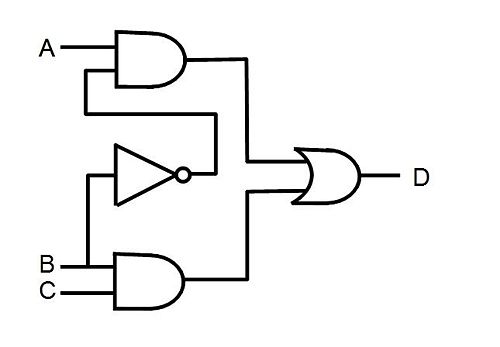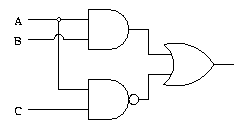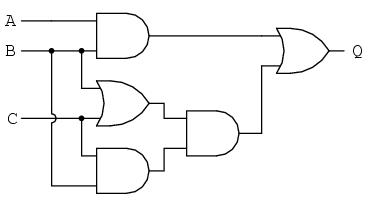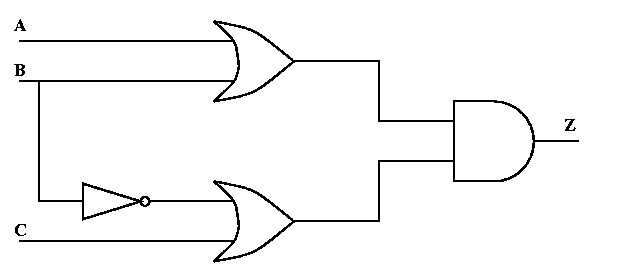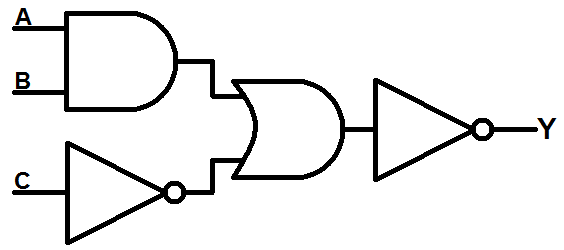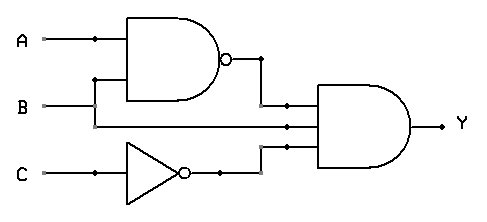Diferență între revizuiri ale paginii „DIC Lab Work 1”
Cbira (discuție | contribuții) |
Cbira (discuție | contribuții) |
||
| Linia 36: | Linia 36: | ||
== Exercise 1 == | == Exercise 1 == | ||
| − | + | Implement the Verilog description of the module with the inputs '''a''', '''b''', '''c''' and the output '''d''' with the functionality shown in the diagram below. Implement the circuit on the DE1/DE1-SoC board by connecting inputs a, b, c to SW2, SW4, and SW6 respectively, and output d to LEDR2. | |
[[File: lab1_ex1.jpg]] | [[File: lab1_ex1.jpg]] | ||
Versiunea de la data 30 mai 2018 09:15
Notions and Knowledge Required
- Using the Altera Quartus II Synthesis Program
- List of pins for plate DE1
- Plate pin list DE1_SOC
- Boolean logic and numbering systems
- Syntax notions Verilog
Example
Create a new project in Quartus II for the Altera Cyclone II FPGA on the DE1 board. Create a Verilog source file within the project, and copy the next module to the file.
Warning! The name of the top-level module to be synthesized should be set correctly when you create the project (in this case, OrGate).
OrGate modules (
output out,
input in1,
input in2
);
assign out=in1 | in 2;
endmodule
Add the necessary constraints for the circuit's inputs and outputs to be connected as follows:
- in1 connected to SW0: PIN_L22
- in2 connected to SW7: PIN_M2
- Out connected to LDR3 (red LED no.3): PIN_Y19
Implement the project on the DE1 board and observe the circuit functionality described by the Quartus II project.
The list of pins to which I /O devices are connected to the DE1 board are described here
Exercise 1
Implement the Verilog description of the module with the inputs a, b, c and the output d with the functionality shown in the diagram below. Implement the circuit on the DE1/DE1-SoC board by connecting inputs a, b, c to SW2, SW4, and SW6 respectively, and output d to LEDR2.
Exercise 2
Make the verilog description of the module with the inputs a, b, c and the output q with the functionality in the diagram below. Implement the circuit on the DE1 board by connecting inputs a, b, c to SW3, SW4, and SW7, and output q to LEDR7.
Exercise 3
Make the verilog description of the module with the inputs a, b, c and the output q with the functionality in the diagram below. Implement the circuit on the DE1 board by connecting inputs a, b, c to SW1, SW6, and SW7, and output q to LEDG3.
Exercise 4
Make the description in Verilog of the module with the inputs a, b, c and the output z with the functionality in the diagram below. Implement the circuit on the DE1 board by connecting inputs a, b, c to SW3, SW4, and SW5, and output z to LEDR6.
Exercise 5
Make the Verilog description of the module with the inputs a, b, c and the output y, with the functionality in the diagram below. Implement the circuit on the DE1 board by connecting inputs a, b, c to SW5, SW6, and SW7 respectively, and output y to LEDG4.
Exercise 6
Make the Verilog description of the module with the inputs a, b, c and the output y, with the functionality in the diagram below. Implement the circuit on the DE1 board by connecting inputs a, b, c to SW5, SW4, and SW1, and output y to LEDR7.
Submission of Exercise Solving
It will solve a single exercise, which will be selected by the teacher. For scoring, the following files will be submitted to the e-mail address indicated by the teacher.
An archive zip
- A Verilog file with the .v extension that contains the Verilog description of the circuit
- A constraint file with the .qsf extension
- A Quartus project file with the .qpf extension
Note that the archive will contain only the 3 files (no directories).
The subject of the email message must follow the [Name] _ [First Name] _ [Group] _ [Exercise Number] For example Petrica_Lucian_423B_2
Recommendations for Teachers
- Implementing a Quartus project example, going through the tutorial.
